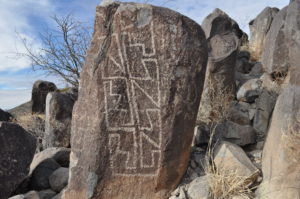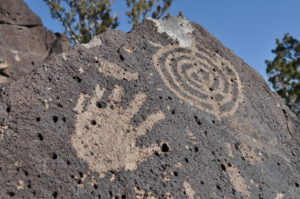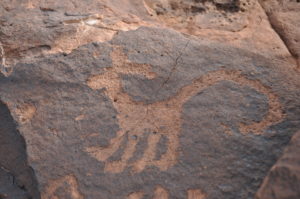By S. Mally
 We are fortunate to be living in New Mexico where you can find petroglyphs in several locations. We have been to the better-known sites such as Petroglyph National Monument in Albuquerque, the Wells Petroglyph Preserve near Velarde, and the Three Rivers Petroglyph site north of Tularosa. Near Santa Fe, we have found amazing panels of petroglyphs at La Cieneguilla and at the Glorieta Mesa. What we enjoy the most, however, is getting off the beaten path and locating petroglyphs in canyons and on sandstone bluffs where they remain mostly hidden and protected.
We are fortunate to be living in New Mexico where you can find petroglyphs in several locations. We have been to the better-known sites such as Petroglyph National Monument in Albuquerque, the Wells Petroglyph Preserve near Velarde, and the Three Rivers Petroglyph site north of Tularosa. Near Santa Fe, we have found amazing panels of petroglyphs at La Cieneguilla and at the Glorieta Mesa. What we enjoy the most, however, is getting off the beaten path and locating petroglyphs in canyons and on sandstone bluffs where they remain mostly hidden and protected.
 What is the allure of these petroglyphs? While I know I cannot properly interpret the images that the ancient people of the American Southwest left on basaltic rocks and sandstone formations, I enjoy using my imagination to decipher their messages. Animal figures are plentiful. Were these images left as notice to other hunters that deer and elk could be found in a given area? What does the spiral represent? The universe? Creation? I’m usually preoccupied photographing as many petroglyphs as possible but I also enjoy taking time to step back and to muse on the meaning of a particular petroglyph.
What is the allure of these petroglyphs? While I know I cannot properly interpret the images that the ancient people of the American Southwest left on basaltic rocks and sandstone formations, I enjoy using my imagination to decipher their messages. Animal figures are plentiful. Were these images left as notice to other hunters that deer and elk could be found in a given area? What does the spiral represent? The universe? Creation? I’m usually preoccupied photographing as many petroglyphs as possible but I also enjoy taking time to step back and to muse on the meaning of a particular petroglyph.
 The Native Americans who left these rock etchings did not have a written language. Petroglyphs were a means for communicating to others and for leaving their interpretations perhaps of the spiritual and celestial worlds. Viewing petroglyphs allows us a glimpse into their world – the challenges they faced, their beliefs and their wish for fertility and abundance. We can never really nail down their true intent but we are so fortunate to have the opportunity to discover places where these ancient people once lived and the messages they left behind.
The Native Americans who left these rock etchings did not have a written language. Petroglyphs were a means for communicating to others and for leaving their interpretations perhaps of the spiritual and celestial worlds. Viewing petroglyphs allows us a glimpse into their world – the challenges they faced, their beliefs and their wish for fertility and abundance. We can never really nail down their true intent but we are so fortunate to have the opportunity to discover places where these ancient people once lived and the messages they left behind.
Take a tour with us and visit the petroglyph site at La Cieneguilla. Or book a hike and go off the beaten path to view a multitude of ancient etchings near the Rio Grande River. Step back into time and contemplate the writings of the ancient people of the Southwest.

